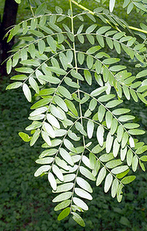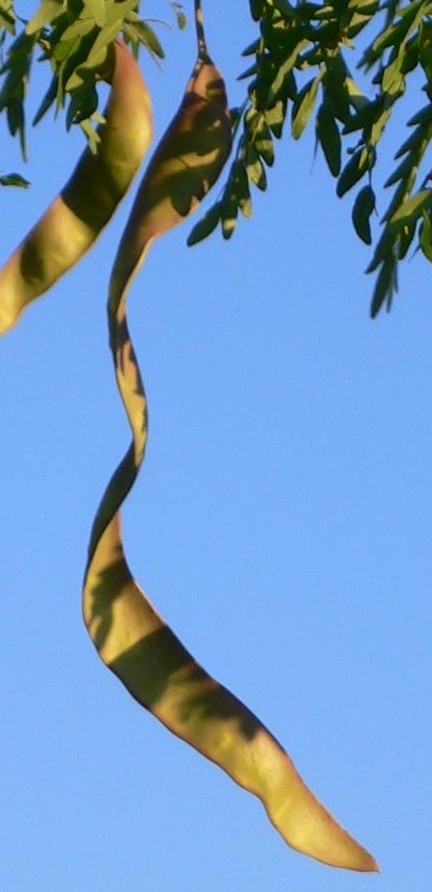 This deciduous tree is native to parts of central United States where it often occupies bottomlands. It is a member of the pea family, Facaceae, that also includes, beans, lupines, and mimosa. The leaves are pinnately or bipinnately compound and the leaflets are small so that raking is rarely necessary. The glossy bright green leaves appear late in the spring and turn bright yellow in the autumn before their early fall. The light shade of the canopy combined with the late appearance and early disappearance of the leaves facilitates the growing of grass beneath the tree. In late spring to early summer spikes of greenish yellow inconspicuous male and female fragrant flowers are produced on different trees. Fertilized female flowers are followed by large twisted brown to purple pods up to 12″ long that can be a considerable litter problem. The short main trunk is gray-brown and develops plate-like patches separated by furrows. It is attractive especially in winter but may bear thorns that can be a hazard. Thornless honey locust is tolerant of drought, short term flooding, salt, compaction, and pollution so can be used in difficult sites including urban area such as parking lots and medium strips. Unfortunately, it is susceptible to a considerable number of pests and disease so should not be planted in mass. The genus name, Gleditsia, honors Johann Gottlieb Gieditsch (1714-1786) , director of the Botanical Garden, Berlin. The specific epithet, triacanthos, the Greek tri- meaning three, and acantha meaning thorn, refers to the three-branched thorns on the species. The varietal name, inermis, is the Latin word meaning unarmed and refers to the lack of thorns on this variety.
This deciduous tree is native to parts of central United States where it often occupies bottomlands. It is a member of the pea family, Facaceae, that also includes, beans, lupines, and mimosa. The leaves are pinnately or bipinnately compound and the leaflets are small so that raking is rarely necessary. The glossy bright green leaves appear late in the spring and turn bright yellow in the autumn before their early fall. The light shade of the canopy combined with the late appearance and early disappearance of the leaves facilitates the growing of grass beneath the tree. In late spring to early summer spikes of greenish yellow inconspicuous male and female fragrant flowers are produced on different trees. Fertilized female flowers are followed by large twisted brown to purple pods up to 12″ long that can be a considerable litter problem. The short main trunk is gray-brown and develops plate-like patches separated by furrows. It is attractive especially in winter but may bear thorns that can be a hazard. Thornless honey locust is tolerant of drought, short term flooding, salt, compaction, and pollution so can be used in difficult sites including urban area such as parking lots and medium strips. Unfortunately, it is susceptible to a considerable number of pests and disease so should not be planted in mass. The genus name, Gleditsia, honors Johann Gottlieb Gieditsch (1714-1786) , director of the Botanical Garden, Berlin. The specific epithet, triacanthos, the Greek tri- meaning three, and acantha meaning thorn, refers to the three-branched thorns on the species. The varietal name, inermis, is the Latin word meaning unarmed and refers to the lack of thorns on this variety.
Type: Deciduous tree
Outstanding Features: Tolerant of a wide variety of sites
Form: Oval or rounded; irregular silhouette; loose, open
Growth Rate: Rapid
 Bloom: Small, greenish-yellow, fragrant flowers in panicles frim late spring to early summer; large twisted green pods up to 12” long turning brown to purple in fall
Bloom: Small, greenish-yellow, fragrant flowers in panicles frim late spring to early summer; large twisted green pods up to 12” long turning brown to purple in fall
Size: 50-75’ H x 35-50’ W
Light: Full sun to part shade
Soil: Fertile, moist, well-drained but tolerates a wide range of soil.
Hardiness: Zones 3-8a
Care: Prune to one leader when young to develop good form and structure; prune in autumn to shape and conrol size.
Pests and Diseases: Mimosa webworm, borers, pod gall midge, spider mites, bagworms, leafminers, aphids, and canker
Propagation: Seed; cultivars by bud grafting
Outstanding Selection:
’Moraine’ (fruitless, 40’ tall, good pest resistance and yellow fall color).
‘Rubylace’ (foliage ruby-red as it emerges in spring, bronze-green in summer and yellow in autumn; 20-35′ tall)
 c
c